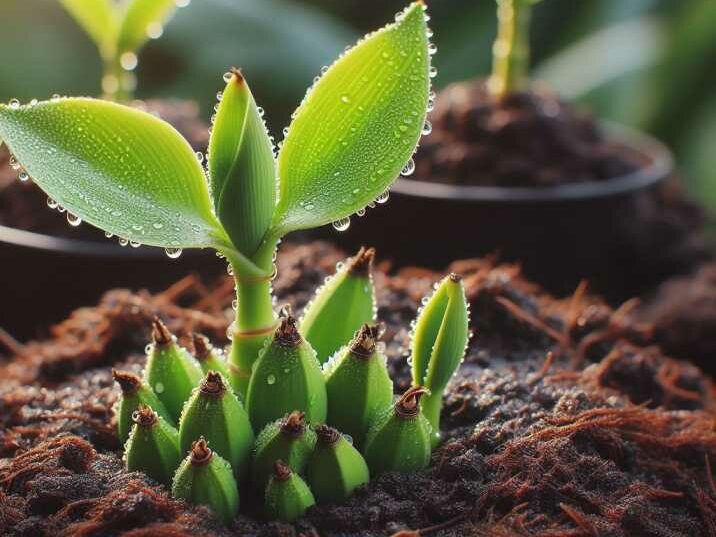Introduction
Table of Contents
Bananas are a beloved tropical fruit enjoyed by people worldwide, but have you ever wondered how these delightful fruits adapt to different soil types? In this comprehensive guide, we will delve into the fascinating world of baby bananas and explore their remarkable ability to thrive in various soil conditions.
Understanding How Do Baby Bananas Adapt to Different Soil Types?
Banana plants, scientifically known as Musa, are native to tropical regions and are renowned for their adaptability to diverse environmental conditions. These plants possess a unique root system that enables them to adjust to different soil types, ensuring their survival and growth.

Soil Types Suitable for Baby Bananas
Baby bananas, like their adult counterparts, thrive in well-drained soils with ample organic matter. However, they can also tolerate a range of soil types, including sandy, loamy, and clayey soils, with varying degrees of success.
Adaptation Mechanisms of Baby Banana Roots
The roots of baby banana plants play a crucial role in their adaptation to different soil types. These roots have specialized structures, such as adventitious roots and feeder roots, which facilitate nutrient uptake and water absorption, enhancing the plant’s resilience.
Strategies for Growing Baby Bananas in Different Soil Types
Whether you’re cultivating baby bananas in sandy soils or clayey soils, implementing the right strategies is key to their success. From soil amendment techniques to irrigation practices, we’ll explore effective methods for optimizing growth in various soil conditions.
Importance of Soil pH for Baby Banana Growth
Soil pH significantly influences the growth and development of baby banana plants. We’ll discuss the ideal pH range for banana cultivation and explore how soil amendments can be used to adjust pH levels for optimal growth.
Nutrient Requirements of Baby Banana Plants
Proper nutrition is essential for the healthy growth of baby banana plants. We’ll examine the specific nutrient needs of these plants and provide insights into fertilization practices to ensure optimal growth and fruit production.
Environmental Factors Affecting Banana Plant Growth
In addition to soil type, several environmental factors impact the growth of baby banana plants. From temperature and humidity levels to sunlight exposure, understanding these factors is crucial for successful banana cultivation.
Common Challenges in Growing Baby Bananas
Despite their adaptability, baby bananas may face challenges in certain soil types or environmental conditions. We’ll discuss common issues such as nutrient deficiencies, pest infestations, and diseases, along with practical solutions to address them.
Tips for Sustainable Banana Cultivation Practices
Promoting sustainability in banana cultivation is essential for preserving the environment and ensuring the long-term viability of banana farming. We’ll share tips for adopting eco-friendly practices, including organic farming methods and soil conservation techniques.
Conclusion:
In conclusion, baby bananas demonstrate remarkable adaptability to different soil types, thanks to their unique root system and physiological mechanisms. By understanding the factors influencing banana plant growth and implementing effective cultivation practices, growers can ensure the successful cultivation of these beloved fruits in diverse soil conditions.
As you embark on your journey to cultivate baby bananas, remember to prioritize soil health, proper nutrition, and sustainable farming practices for optimal growth and fruit production.
FAQs
FAQ 1: How do baby bananas adapt to sandy soil?
Answer: Baby bananas possess a remarkable ability to adapt to sandy soil by developing a deep root system that enables them to access water and nutrients efficiently. Additionally, their fibrous roots help anchor the plants securely in the loose sandy substrate, ensuring stability and support for optimal growth.
FAQ 2: What are the nutrient requirements of baby banana plants?
Answer: Baby banana plants require a balanced supply of essential nutrients, including nitrogen, phosphorus, potassium, magnesium, and calcium, for healthy growth and development. Adequate fertilization and soil amendments are crucial to meeting these nutrient requirements and promoting robust plant growth and fruit production.
FAQ 3: Can baby bananas thrive in clayey soil?
Answer: While baby bananas prefer well-drained soils, they can adapt to clayey soil conditions with proper soil management techniques. Clayey soils tend to retain moisture, which can be beneficial for banana plants, but adequate drainage and soil amendment with organic matter are necessary to prevent waterlogging and promote healthy root development.
FAQ 4: What are the common challenges in growing baby bananas?
Answer: Common challenges in growing baby bananas include nutrient deficiencies, pest infestations (such as nematodes and aphids), fungal diseases (like Panama disease and Sigatoka leaf spot), adverse weather conditions, and competition with weeds. Implementing integrated pest management strategies, proper irrigation, and soil health management can help mitigate these challenges effectively.
FAQ 5: How can I promote sustainability in banana cultivation practices?
Answer: Promoting sustainability in banana cultivation involves adopting eco-friendly farming practices that minimize environmental impact and conserve natural resources. This includes practices such as organic farming methods, using natural pest control measures, implementing water-saving irrigation techniques, practicing soil conservation, and promoting biodiversity in banana plantations. By prioritizing sustainability, growers can contribute to the long-term viability of banana farming while preserving the environment for future generations.
